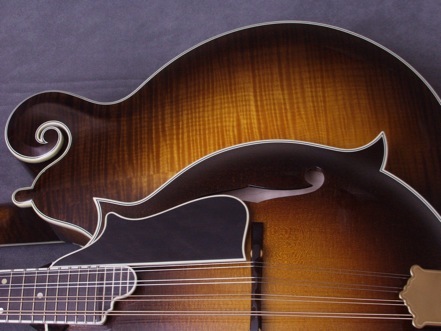MANDOLINS & MANDOLAS:
The strongest influence on the design and construction of my mandolins and mandolas are the Loar era instruments of the early 1920s. These great mandolin family instruments provide a starting point for my own work. Using a combination of construction methods that have produced world class instruments for centuries, tried and trued modern methods, as well as my own unique techniques, I assemble each instrument by hand. The process starts with the initial shaping of air dried split billets to form the top and back plates, and continues through the assemblage of rim and neck. These four forms then become one, are fully bound, the final touches being hand cut head stock inlay, fretting, installation of hardware, fitting the bridge, and finally, a spirit varnish finnish. Hide glue is used through out.
Top wood is typically Engelmann spruce, with its wide range of densities and weights allows a range of tonal colorings from gritty and percussive to singing bell like tones. I usually take the middle road, to get the best of both worlds, but also build with wood on either end of the spectrum to satisfy others personal taste. Tops with F-holes are braced with either Red or Sitka spruce tone bars. Oval hole instruments (A-4, F-4, H-4) are X-braced. Backs and sides are typically
curly eastern Red maple, the sides quartered to slightly off quarter when milled, the backs either book matched quartered or one piece slab cut. I also build with western Big Leaf backs and sides, as well as eastern Sugar maple.
The necks are one piece eastern Sugar maple reinforced with a ridged 7/16th” square graphite rod that extends all the way into the head stock. Graphite is light, strong, and transmits vibrations extremely well making it an excellent choice for stabilizing mandolin and mandola necks. Fingerboards are radiused ebony (12”) and have 20 playable nickel silver frets. Frets 21 through 24 are false frets of inlayed maple and are in the fingerboard extension area, which is “scooped” for pick clearance. Position markers are on the fingerboard face and sides at frets 5, 7, 10, 12, and 15. Pick guards are bound ebony (Birdseye maple on blond instruments). Bridges are ebony, built on a series of 15 jigs (using a router and a drill press) which produce the blanks that fit my mandolins perfectly. The blanks just need a final polishing before installation. Mandola bridges are still made one at a time.
A standard head stock inlay is hand cut from mother of pearl and abalone. Waverly tuners are standard on F-5s and (A-5s & H-5s have Schallers) and can be fitted with a variety of tuner buttons (ivoroid, ebony, or mother of pearl). Tuners can be mixed and matched on any instrument with the total price adjusted accordingly. Tail pieces are either a James or Allen, in gold, silver, or nickel. Mandolins are fully bound. There are several color schemes available from blond to sunburst, finished with a French Polished spirit varnish. A hard shell TKL is included in the price of each mandolin or mandola. Calton cases are available for an additional charge. All instruments are built with the finest quality instrument grade materials.





